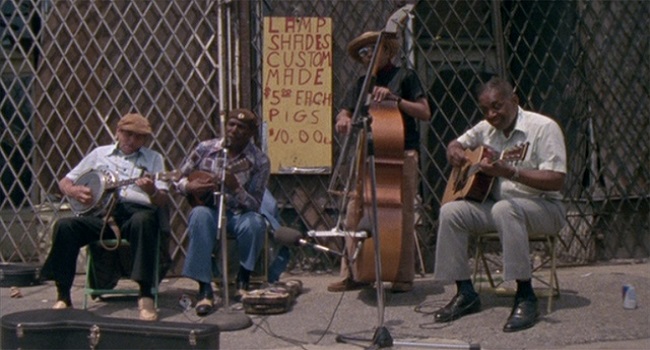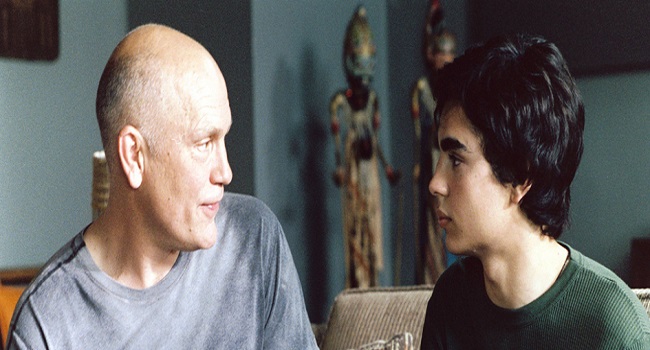Among the group of filmmakers who helped to make the documentary film genre a viable place in the world of American cinema, Terry Zwigoff is a figure that has managed to carve out his own unique space in independent films. Similar to those he has profiled in his documentaries and narrative films, Zwigoff is an eccentric that champions other oddballs and misfits of conventional society. While it’s been nearly a decade since his last film, Zwigoff still holds a special place for those who feel they don’t belong. He has become the unlikely voice for the outsiders of the world.
Born in Appleton, Wisconsin on May 18, 1949, Terry Zwigoff, the son of Jewish dairy farmers, eventually moved to Chicago at the age of five. There, he fell in love with, and immersed himself in, both art and American roots music. In the early 1970s, Zwigoff went to San Francisco where he met, and became good friends with, famed underground artist Robert Crumb. During his lengthy friendships with Crumb, he even played in Crumb’s string band R. Crumb and his Cheap Suit Serenaders, Zwigoff became interested in the medium of film.
Louie Bluie (review)
For his first foray into the world of film, Zwigoff returned home to Chicago to make a documentary, Louie Bluie, on the famed, but obscure, country-blues musician/artist Howard “Louie Bluie.” Armstrong. Shot over the course of a year, with the aid of cinematographers John Knoop and Chris Li, Zwigoff explored the culture of American roots music through the eyes of the musician and his collaborator Ted Bogan. The film also touched on Armstrong’s other artistic talents, ranging from painting to creating necklaces, as well as his fascination for pornography.
While it is clear that Armstrong is an eccentric individual, Zwigoff showed that his quirks were part of the man’s overall charm. At the end of the day, Armstrong was a guy who loved to play music regardless of whether or not he had an audience. Louie Bluie played at various film festivals throughout 1985; but it took until 2010, thanks to a Criterion Collection DVD/Blu-Ray release, before the public could finally see the film.
Crumb (review)
After the minor festival success of Louie Bluie, Zwigoff had the idea of filming a documentary about his friend Robert Crumb. At first Crumb wasn’t keen on the project but eventually gave in after some persistence on Zwigoff’s part. Filmed over nine years, with cinematographer Maryse Alberti shooting the film, Crumb offered a very deep look into Crumb’s life, art and his views on society. Zwigoff was given access to several of the artist’s family members with the exception of two sisters who declined to take part in the film.
It was in talking to Crumb’s mothers and his two brothers that Zwigoff learn about some of the mental illness issues within the Crumb family. This added to the sense of disconnect between Crumb and modern society, the latter of which the artist admitted to have little understanding for. Leaving the U.S. to live in the South of France, the family suffered a great loss when Crumb’s brother, Charles, commit suicide a year after the documentary was completed.
Crumb premiered at the 1995 Sundance Film Festival and won the festival’s grand jury documentary prize. The film did modestly well in its limited release, making more than $3 million, and garnered rave reviews. Although many considered it a lock for an Oscar nomination in the Best Documentary category, controversy arose when it was revealed that certain members of the academy only watched 20 minutes of the film. While Zwigoff felt indifferent to the Oscar snub, he was just happy about the film’s success, the controversy fueled a change in the academy’s nomination process.
Ghost World (review)
The success of Crumb caused studios to come knocking on Zwigoff’s door, but he was reluctant to work on the type films they were offering him. In the late 1990s, Terry Zwigoff met comic writer Daniel Clowes, whose comic series Ghost World he was a big fan. The story revolved around the lives of two teenage girls who cope with their disdain towards society and the changes that come with their pending adulthood. Zwigoff and Clowes worked on the screenplay but weren’t enthused by the direction most studios wanted to take the film. It was not until they met with producer Lianne Haflon, whom Zwigoff worked with on Crumb, that the film fell into place.
With a $7 million budget, and actor John Malkovich on board as one of the film’s producer, Zwigoff enlisted the services of famed Spanish cinematographer Affonso Beato to shoot the film. Thora Birch and Scarlett Johansson, 18 and 15 respectively at the time, were cast in the lead roles of Enid and Rebecca. However, the biggest coup for Zwigoff was landing Steve Buscemi in the role of Seymour, a loner who the girls befriend. The rest of the cast featured Teri Garr, Illeana Douglas, Brad Renfro, and Bob Balaban. Zwigoff also received contributions from Robert Crumb’s daughter Sophie, who provided the artwork that Enid’s character draws in the film. He also hired composer David Kitay, whose piano-based score added to the melancholic tone of the film.
Ghost World made its premiere at the 2001 Seattle International Film Festival and was a major hit on the festival circuit. The film received a limited release through MGM/United Artists and garnered $8 million at the worldwide box office. Riding a wave of rave reviews, Thora Birch and Steve Buscemi received Golden Globe nominations; while Zwigoff and Clowes received their first Oscar nomination in the Best Adapted Screenplay category.
Bad Santa (review)
Although Terry Zwigoff had been avoiding working within the limited confines of the studio system, his view changed after he was approached by Joel and Ethan Coen about helming Bad Santa, a film that they were attached to but had no interest in directing. The story involved an alcoholic, and self-loathing, thief who poses as a shopping mall Santa Claus in order to rob the mall on Christmas Eve. Although the Coen brother did re-writes on the script, the original screenplay writers, Glenn Ficarra and John Requa, retained credit under the rules of the Writer’s Guild of America.
Jack Nicholson and Bill Murray were both approached to play the lead role, but the role ultimately went to Billy Bob Thornton. The rest of the ensemble cast included Lauren Graham, Brett Kelly, Bernie Mac, Tony Cox, and John Ritter (who died of a heart attack a few months before the film was released). The one point of contention between Zwigoff and the Coen brothers was the casting of Tony Cox in the role of Thornton’s accomplice. Zwigoff fought hard to get Cox into the film, but that issue was considered minor compared to the battle the director had with the Weinstein Brothers over the budget. It got so bad that another director was brought in to re-shoot some scenes since Zwigoff’s didn’t have final cut.
Bad Santa was greeted with excellent reviews upon its release, and gave Zwigoff his best box office gross to date with a worldwide total of $76 million. However, Zwigoff was mixed about the film’s commercial success and worked with editor Robert Hoffman to craft a Director’s Cut. Zwigoff’s preferred version eventually came out three years after the film’s original theatrical release. Though the Director’s Cut got some praise, many felt the theatrical version of the film was the definitive version.
Art School Confidential (review)
Wanting to make a film where he had complete control, Zwigoff reunited with Ghost World writer Daniel Clowes to adapt another one of Clowes’ comics. Art School Confidential told the story of a young art student named Jerome who finds himself dealing with the chaos of art school, including its many cliques, critiques, and personalities. Max Minghella was cast in the lead role of Jerome, and Zwigoff filled out the rest of the ensemble with Sophia Myles, Anjelica Huston, Jim Broadbent, Matt Keeslar, Adam Scott, Joel David Moore, Ethan Suplee, Steve Buscemi, and John Malkovich, who also produced the film, as an art teacher.
Working with cinematographer Jamie Anderson, and regular collaborators Robert Hoffman and David Kitay, Zwigoff wanted to capture both the absurdity of art school, where everyone believes that they’re great artists in the making, and the fallacy of ambition in the art world. This is emphasized in a sequence when Jerome attends a seminar held by a famous artist who uses arrogance as tool to teach students how to approach art and fame. The film also featured a subplot about a mysterious individual and a student trying to make a film about him.
Art School Confidential made its highly anticipated premiere at the 2006 Sundance Film Festival. The reaction was very divisive. While some enjoyed its humor, others felt the film lost itself in the strangler subplot. The film did poorly in the box office only grossing only $3 million against its $5 million budget. The lukewarm critical reaction did not help things either. Despite being approached to direct the film Juno, which was also produced by John Malkovich and Lianne Haflon, Terry Zwigoff has not directed a film since Art School Confidential.
It has been a decade since his last release hit theaters. Terry Zwigoff has had several projects in development during that time that have yet to get off the ground. While his films maybe off the wall, he has carved out place in independent cinema being the voice for misfits and outsiders. Zwigoff manages to find ways to make these individuals endearing and relatable to audiences.
© thevoid99 2016
4 Comments
Comments are closed.







This is a pretty good reminder of how varied his portfolio is!
Exactly, I just wish he made more films.
It’s great that Ghost World was nominated for best adapted screenplay.I read the book and it’s a good translation. Sad to hear Crumb got snubbed but it is cool that more people have seen it. I still need to see Director’s cut of Bad Santa.
I have the graphic novel and the screenplay book as it’s still my favorite thing that Zwigoff did. What happened w/ the Oscars as it relates to Crumb was bullshit as it at least did make some change for the Academy about what to do.